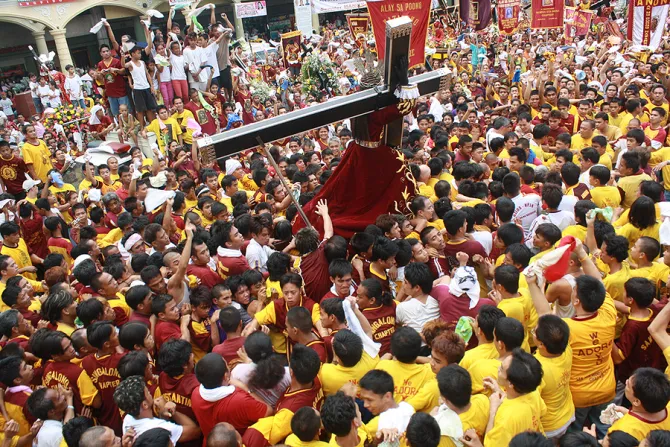Manila, Philippines, Jan 13, 2016 / 21:43 pm
Millions of Catholic faithful swarmed the streets of metro Manila for the procession of the Black Nazarene over the weekend, as clergy encouraged the devotees to use the occasion to reflect on Jesus Christ's path to Calvary.
Cardinal Antonio Tagle, the Archbishop of Manila, presided at the midnight Mass at Manila's Quirino Grandstand hours before the procession began on Saturday morning. In his homily, he encouraged the faithful to "hold on to Jesus."
Cardinal Tagle put forward questions to devotees who endured hunger, thirst and heat.
"Why do you sacrifice every year? Getting less sleep, getting hungry? Others get injured, others faint because of the heat... But why do you keep doing it? The common answer is: this is my way of showing our gratitude."
He told the pilgrims that they were not the ones who reached out to Christ. Rather, it was Christ who came to reach out to them.
"When you feel you are alone and you have no one to hold on to… have faith. Hold on to Jesus," he repeated. "Jesus is carrying you."
The statue of the Black Nazarene is a kneeling Christ cloaked in a maroon robe and crowned with thorns. The life-sized statue bears a cross.
It was brought to the Philippines by Augustinian missionary priests in 1606. The statue is believed to have acquired its black color after being partially burnt when the ship carrying it caught fire on a voyage from Mexico.
Since then it has survived fires that destroyed its host church twice, two earthquakes, floods from numerous typhoons and bombings during World War II. The image is normally enshrined in Manila's famous Minor Basilica of the Black Nazarene, popularly known as the Quiapo Church.
The Feast of the Black Nazarene was observed Saturday Jan. 9 with a traditional barefoot procession returning the statue to its church. Many devotees wore maroon and yellow shirts as they reflected on the passion of Christ and venerated the image.
The statue was wheeled for 4.3 miles from the grandstands to the church in the practice locally known as the "Traslacion."
Many miracles have been attributed to the devotion to the Black Nazarene. Some pilgrims energetically vaulted over each other to touch the statue with white handkerchiefs. Others clung to the rope hauling the cart which bore the statue.
Monsignor Jose Clemente Ignacio, the former rector of Quiapo Church, said the pilgrimage is "imitating the Calvary experience: the sacrifice and suffering that our Lord endured for our salvation like when Jesus was walking barefoot, carrying the cross to Mount Calvary." He said the pilgrims "want to give back to God by participating in the suffering of our Lord and entering into the Paschal mystery of Christ."
Cardinal Tagle reflected on the devotion.
"To understand the devotee you have to be a devotee," he said in his homily. "Only a devotee could best understand a devotee."
The huge crowds and 20-hour procession were not without risk – or controversy. More than 1,500 people reported suffering injuries, while two people were reported to have died, one of cardiac arrest and the other of acute coronary syndrome. Last year's pilgrimage also saw two deaths. Quiapo Church's rector Msgr. Hernando Coronel responded to the deaths and injuries by voicing his deep sadness and urging prayers.
But Cardinal Tagle reflected in his homily before the procession that the sometimes tumultuous nature of the pilgrimage was not the point.
(Story continues below)
"For the others who think the devotees are just shoving each other. That is not true!" he said. "Have you ever experienced having nothing more to hold on to? Once you've experienced that, then the Nazarene is there for you."
"Go to him, hold on to him and you will understand why the devotees just want to get near him. You don't have anyone to hold on to, but the Nazarene is there," he said.
Last year in 2015, estimated participation in the procession exceeded 5 million people, an increase of one million since 2014. The numbers could be higher this year.
Cardinal Tagle praised how so many devotees lined up for more than seven hours to venerate the image. The traditional act of veneration is locally known as a "pahalik." The devotee kisses or touches the image for a few seconds at the Quirino Grandstand.
This year's procession began early Saturday at 5:30 a.m. and concluded at Quiapo Church on Sunday at 2 a.m. The procession is the fastest in the last five years.
Msgr. Coronel has praised improvements to the pilgrimage, including better communication tools and facilities. He voiced gratitude for the effective co-ordination between the Church, volunteers, committees and the partnership with various NGOs and government agencies.
The Philippines' national police deployed over 4,000 personnel to ensure security and safety.
The Quiapo Church draws thousands of faithful for Mass, Confession, Adoration of the Blessed Sacrament and prayers for the sick. The faithful have reported many miracles and graces.


